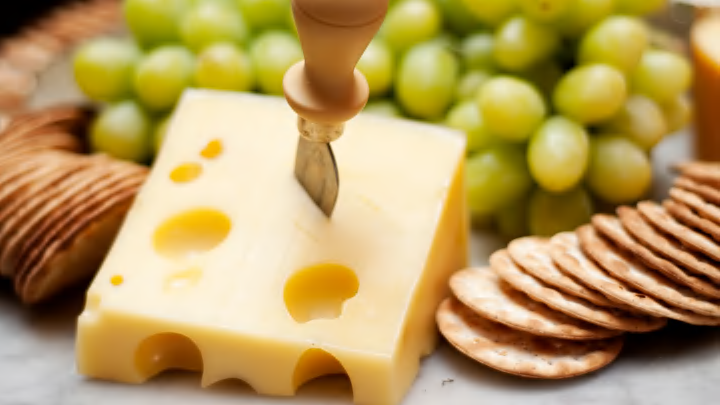One of the most recognizable cheeses is the Swiss variety. Even if you don’t know the taste, you’re likely familiar with the distinctive appearance characterized by an abundance of holes, also known as “eyes.” But where exactly does the dairy product get its looks from? The answer has nothing to do with mice chewing through the cheese.
Bacterial Bubbles

According to U.S. Dairy, a farmer-funded trade group, the eyes in Swiss cheese derive from a genus of bacteria often found in raw milk called Propionibacteria, or Props. Prior to the advent of pasteurization (a heating process that kills bacteria), such microbes occurred naturally in cheese. Today cheesemakers have to add Props back into the dairy product after pasteurization.
Swiss cheese is made by placing curds in a warm room to ferment for months. Fermentation occurs when microbes consume the sugar and carbohydrates in food, thus generating byproducts like lactic acid. In the case of Swiss cheese, Propionibacteria gobble up the lactic acid that’s left behind, which creates carbon dioxide. This gas expands parts of the cheese and forms the characteristic bubbles.
You May Also Like:
- The Scientific Reason Cheddar Cheese Tastes So Good
- 11 Things You Might Not Know About Cheese
- How 10 Classic Foods Made Their Way to America
- Map Shows the Most Popular Pumpkin Foods Across the Country
Add Mental Floss as a preferred news source!
Does Swiss Cheese Always Have Holes?
In the U.S., people often use Swiss cheese as a generic term, but those in Switzerland refer to the dairy item as Emmental. The USDA monitors the quality of Swiss cheeses by noting the number, size, and distribution of their eyes. While most Swiss cheeses have eyes, some don’t, according to U.S. Dairy. In this case, producers would say these pieces are “blind,” but they still taste the same.
Swiss cheese is best known for its sizable holes, but it’s not uncommon for other cheeses, such as Havarti, Tilsit, and Gouda, to have smaller gaps as a natural byproduct of the fermentation process.
